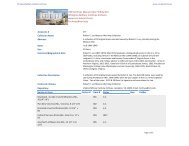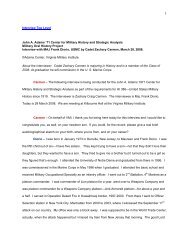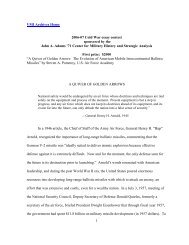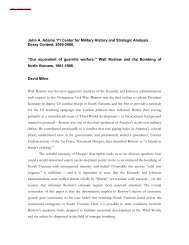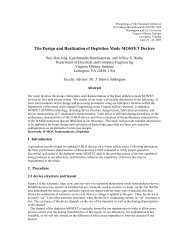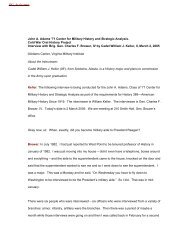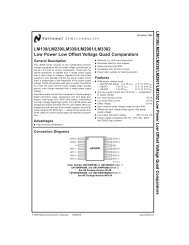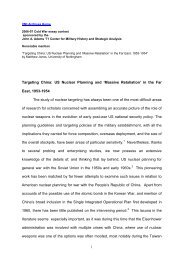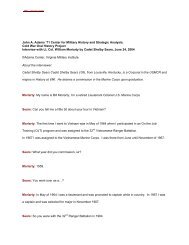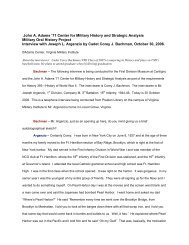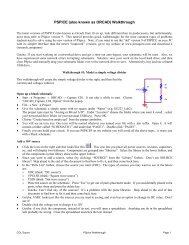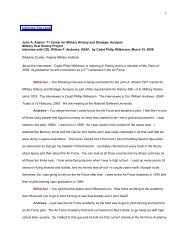Academic Catalog - Virginia Military Institute Admissions
Academic Catalog - Virginia Military Institute Admissions
Academic Catalog - Virginia Military Institute Admissions
Create successful ePaper yourself
Turn your PDF publications into a flip-book with our unique Google optimized e-Paper software.
<strong>Virginia</strong> <strong>Military</strong> <strong>Institute</strong><br />
12-13 <strong>Catalog</strong>ue<br />
EE 129. Introduction to Digital Logic Circuits 3—0—3<br />
Introduction to the fundamentals of combinational and sequential digital logic circuits.<br />
Combinational logic topics include number systems and information representations, switching<br />
algebra, basic logic gates, and logic circuit minimization. Medium-scale functions such as<br />
multiplexers, decoders, and adders are also covered. Sequential logic topics include latches<br />
and flip-flops, clocks, timing analysis, and metastability. Combinational logic and flip-flop<br />
principles are used in conjunction with state concepts to analyze and synthesize sequential<br />
machines. Medium-scale sequential functions such as registers, counters, and shift registers<br />
are also covered. Emphasis is placed on the analysis and synthesis procedures used to<br />
design combinational and sequential logic systems. Prerequisites: EE 111-115 or permission<br />
of the instructor. ECE majors must complete this course with a grade of C or better.<br />
EE 223. ELECTRICAL CIRCUIT ANALYSIS 3—2—4<br />
Electrical Circuit Analysis II, is the second course in a series designed to provide engineering<br />
majors the tools to analyze and design passive analog circuits. This course introduces<br />
capacitors and inductors, and develops the natural and forced responses of first and<br />
second-order circuits containing these elements. It introduces complex phasor notation in<br />
the context of sinusoidal steady-state analysis, and then further develops these concepts<br />
in the analysis of single and three-phase AC power. The laboratory portion of the course<br />
introduces the practical skills of designing, building, and debugging physical circuits in the<br />
context of relevant contemporary examples. It includes a major design 4-lab sequence in<br />
which cadets design and build a project of their choice. Prerequisite: MA 124, C or better<br />
in EE 122. Corequisite: MA 311.<br />
EE 225. ELECTROMAGNETIC FIELDS 3—0—3<br />
Electromagnetic fields is the first of two courses designed to provide the engineer with the<br />
tools to analyze electric and magnetic fields. The course explores Maxwell’s equations for<br />
static systems. Electrostatics: fields in vacuum and material bodies, Coulomb’s law, Gauss’<br />
law, divergence theorem, Poisson’s and Laplace’s equations with solutions to elementary<br />
boundary value problems. Magnetostatics: fields in vacuum and material bodies, Ampere’s<br />
law, Biot-Savart’s law, Faraday’s law, and Stoke’s theorem. Prerequisites: MA 215.<br />
EE 228.Digital Systems Design 2—2—3<br />
Combinational and sequential medium-scale functions are reviewed and used in<br />
conjunction with register-transfer language (RTL) and hardware description languages to<br />
design complex digital systems. Principles of modularity, hierarchical methods, controller/<br />
datapath partitioning, and a top-down approach are considered in the design process. A<br />
hardware description language such as Verilog and programmable logic devices are used<br />
in the laboratory to implement digital systems resulting from the aforementioned design<br />
process. Prerequisites: EE 129.<br />
EE 230. SIGNAL AND SYSTEM ANALYSIS 3—0—3<br />
Signals and Systems introduces the Fourier and Laplace transforms as methods to model<br />
and analyze continuous-time linear systems (primarily first and second-order circuits) in<br />
the frequency domain. Parallels between the time and frequency domains are discussed,<br />
and sampling and filter design issues are developed. The course makes extensive use of<br />
Matlab as a computational and visualization tool. In-class labs reinforce theory and develop<br />
hardware skills. Prerequisite: EE 223.<br />
EE 255. ELECTRONICS 3—2—4<br />
Electronics is the first of two courses designed to provide the engineer with the tools to<br />
analyze a circuit and to design a circuit in which diodes and transistors are major components.<br />
Semiconductor theory: doped materials, diodes, bipolar junction transistors, and field-effect<br />
transistors. Analysis and design of small-signal single stage amplifiers and digital logic<br />
circuits. The laboratory portion will cover diode circuits, BJT/FET biasing schemes, and<br />
BJT/FET small-signal amplifier configurations. Prerequisite: EE 223.<br />
EE 321X. SYSTEMS DESIGN I 3—0—3<br />
Part one of a capstone course in the methodologies and attributes of systems design. Topics<br />
include the engineering design process, identification of needs, developing a requirements<br />
specification, generating and evaluating concepts, design tools, and professional skills<br />
such as teamwork and project management. Particular emphasis is placed on system<br />
decomposition, generating behavioral models and testing. Engineering ethics and engineering<br />
economy are also presented.<br />
EE 328. Computer Architecture<br />
(cross-listed with CS 316 Computer Systems) 3—0—3<br />
An introduction to the architecture and design of digital computers. Topics include instruction<br />
sets and assembly language programming, computer arithmetic, central processing units,<br />
pipelines, memory systems, input/output systems, and RISC and CISC concepts. Digital<br />
computers are modeled as complex digital systems to which digital systems design methods<br />
can be applied. Prerequisites: EE 228.<br />
EE 339. MICROCONTROLLERS 3—2—4<br />
Fundamentals of microprocessors and microcontrollers and their use in embedded systems.<br />
Topics include basic architectures, address modes, memory and input/output interfacing,<br />
interrupt-driven processing and assembly language programming. The use of C programming<br />
for microcontrollers is also considered. Projects involving the use of microcontrollers to<br />
solve embedded system design problems such as motor controls, display drivers, analogto-digital<br />
conversion, etc. are integrated in both the laboratory and lectures. Prerequisites:<br />
EE 328 or permission from the instructor.<br />
EE 351. ELECTRICAL CIRCUITS AND MACHINES 3—0—3<br />
Analysis of D.C and A.C. electrical circuits. Element equations, Kirchhoff’s laws, network<br />
theorems, power, phasor techniques, 3-phase systems and transformers; introduction to<br />
rotating machines. Prerequisites: MA 124. For non-electrical engineering students.<br />
EE 352. ELECTRONIC DEVICES 2—2—3<br />
Fundamentals of solid-state devices, amplifier circuits, theory of electronic instruments,<br />
sensors, digital interfacing techniques, and an introduction to control systems. Laboratory<br />
used to demonstrate principles. Prerequisite: EE 351. For non-electrical engineering students<br />
.<br />
EE 356. ELECTRONIC APPLICATIONS AND INTERFACING 2—2—3<br />
Electronic Applications and Interfacing is a continuation of EE-255 Electronics. Tools<br />
and techniques taught in EE-255 are applied to the design of practical electronic circuits<br />
in the course of solving electronics and engineering problems. Operational amplifiers and<br />
their characteristics are used to design linear and non-linear circuits to solve analog circuit<br />
problems. The Barkhausen criteria are presented for the desin of oscillators and waveform<br />
generation. Basic electromagnetic principles are used to provide methods of grounding<br />
and shielding, power supply decoupling, and the termination of transmission lines to<br />
minimize the effects of external and internal noise sources. Power switching techniques<br />
including transistor switches, h-bridges, and pulse-width modulation are used to interface<br />
transducers and various types of actuatior. Power supply design is studied using linear<br />
regulation approaches and introductory switching methods. Digital-to-analog and analogto-digital<br />
conversions may also be presented. Circuit simulation software is used throughout<br />
the course and typical circuit applications are designed, implemented, and tested in the<br />
laboratory. Prerequisite: EE 255.<br />
EE 372W. ELECTRONIC COMMUNICATIONS 3—2—4<br />
Principles of electronic digital communications theory and systems including AM, FM, PAM,<br />
and PCM. Fourier analysis techniques are developed and broadly applied both in class and<br />
in the supporting laboratory exercises. Also included are introductions to: information theory,<br />
encoding theory, and noise. Trade-offs among signal power, noise and system bandwidth<br />
versus system channel capacity are thoroughly developed. Prerequisites: EE 230 and EE<br />
356. Writing Intensive (W).<br />
EE 381. AUTOMATIC CONTROL SYSTEMS 2—2—3<br />
Properties of closed loop (feedback) control systems. Analysis of both analog systems<br />
(in open and closed loop configurations) using: transfer functions, Mason gain, and state<br />
space techniques. Modeling of electromechanical systems (translational and rotating).<br />
System design methods using Bode plots, gain and phase margin. Controllability and state<br />
variable feedback concepts. Root locus and designs to meet pole placement and time<br />
response specifications are stressed. Knowledge of Laplace transforms and matrix algebra<br />
is expected. Prerequisites: EE 230, MA 311.<br />
EE 413. MICROELECTRONICS 2—2—3<br />
This course emphasizes microelectronic circuit design and fabrication, and stresses a<br />
familiarization with both established and emerging technologies including: thick/thin films,<br />
3D and multichip modules, nanotechnologies, printed circuit board technologies, surface<br />
mount technologies, MEMs/NEMs, optoelectronics, biotechnologies, and advanced electronic<br />
materials, packaging, and interconnections. Laboratory experiments involving multiple<br />
technologies will complement the lectures throughout the course.<br />
EE 420. GREEN ENERGY POWER CONDITIONING 2—2—3<br />
Basic theory and operation of power conditioning required for green energy such as Solar<br />
Photo Voltaic (SPV) and wind power are covered. Specifically DC-to-DC converters such as<br />
buck, boost, buckboost, and four quadrant power conditioning are investigated. AC-to-DC<br />
power conditioning techniques are also covered along with DC-to-AC inverters. Analysis<br />
and design of power conditioning systems required for green energy applications which<br />
employ some combination of DC-to-DC, AC-to-DC, and DC-to-AC power conditioning is<br />
stressed. Prerequisite: EE 255.<br />
EE 422. SYSTEMS DESIGN II 0—3—3<br />
Part two of a capstone course in the methodologies and attributes of systems design.<br />
Teams of cadets realize the system that was proposed in part one of the course sequence.<br />
Once implemented and tested, the system design is explored in a formal oral presentation<br />
to the faculty accompanied by a formal written report. Prerequisite: EE 321.<br />
EE 426. SEMICONDUCTOR DEVICES 2—2—3<br />
Topics include: overview of microelectronics fabrication processes; photolithography<br />
techniques; oxidation theory, processing and characterization; diffusion theory, processing,<br />
and characterization; film deposition techniques; interconnections and contacts in<br />
integrated circuits; microelectronic packaging options; and MOS device process integration.<br />
The laboratory portion of the course will focus on clean room protocol, and the use of<br />
semiconductor processing equipment in the fabrication and characterization of resistors,<br />
diodes, and transistors on silicon wafers.<br />
EE 431. DIGITAL SIGNAL PROCESSING 3—2—4<br />
Digital Signal Processing discusses the representation of discrete-time signals and systems<br />
using time-domain methods such as convolution and frequency-domain methods including<br />
the DTFT (Discrete Time Fourier Transform), the DFT (Discrete Fourier Transform), and the Z<br />
transform. Other topics include digital filter design and analysis, the impact of sampling in<br />
the time and frequency domains, and the design of anti-aliasing and reconstruction filters.<br />
The laboratory will emphasize practical considerations involved with the implementation<br />
of DSP algorithms. MATLAB will be used for digital signal generation, plotting and the<br />
implementation and analysis of DSP operations. Prerequisite: EE 230.<br />
EE 435. FAULT TOLERANT COMPUTING 2—2—3<br />
This course covers techniques for designing and analyzing fault tolerant digital systems.<br />
The topics covered include fault models and effects, fault avoidance techniques, hardware<br />
redundancy, error detection and correction, time redundancy, software redundancy,<br />
combinatorial reliability models. In addition, Markov reliability modeling, Markov availability<br />
88




